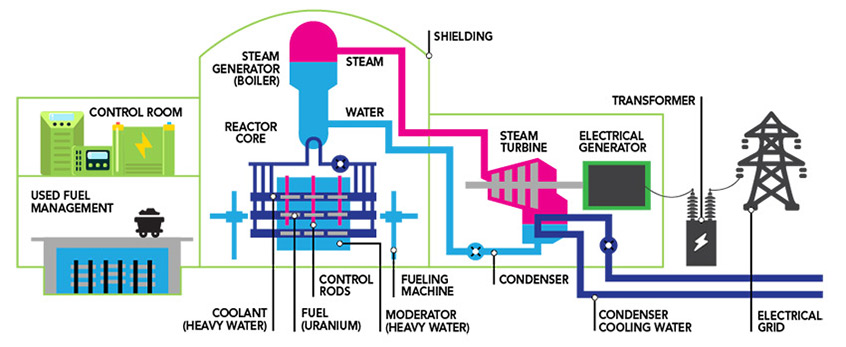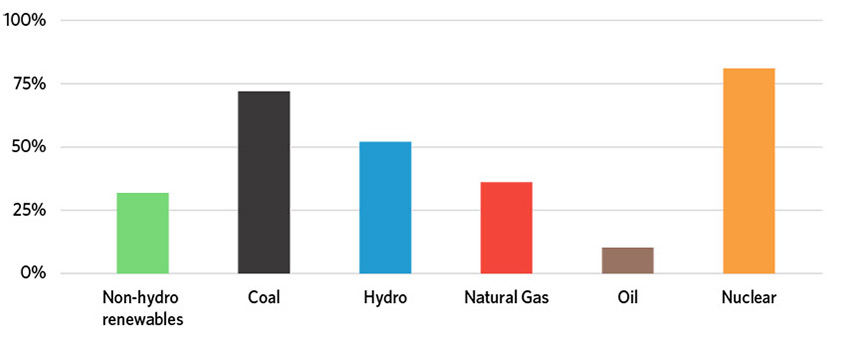ARCHIVED – Nuclear Electricity Generation
This page has been archived on the Web
Information identified as archived is provided for reference, research or recordkeeping purposes. It is not subject to the Government of Canada Web Standards and has not been altered or updated since it was archived. Please contact us to request a format other than those available.
Electricity can be generated from numerous sources, including nuclear, hydro, natural gas, coal, and non-hydro renewables such as wind, biomass, and solar. Nuclear power generation, like generation from fossil fuels, uses thermal energy to generate electricity. However, nuclear generation does not emit any greenhouse gases (GHGs). Heat boils water, producing steam, which turns a turbine and generates electricity. While fossil fuels are burned to create heat, nuclear power generation uses a process called fission to heat the water. In nuclear fission, energy is released when atoms are split apart to form smaller atoms. All Canadian nuclear generation facilities use Canadian Deuterium Uranium (CANDU) reactors, which use uranium from Saskatchewan as fuel.
Figure 1: CANDU Reactor

Source: Canada Nuclear Association
Potential Small Modular Reactor (SMR) Development in Canada
Small modular reactors (SMRs) are small nuclear reactors with the capacity to produce 300 MW or less. Compared with conventional nuclear power plants, SMRs are less expensive and faster to build, can be scaled in size, and have more flexible site requirements. Three SMRs are currently in operation in the world; one each in China, India, and Serbia. Many more are in the planning and construction stages across the globe.
Currently, SMRs have no market penetration in Canada but could play a larger role in Canada’s energy mix in the future. Due to the uncertainty around the development of SMRs in Canada, they are not included in the projections shown in this report.
Natural Resources Canada is developing an SMR Roadmap which involves funding to drive SMR development and deployment in Canada. For more information on SMRs, please see Natural Resources Canada and the World Nuclear Association.
Capacity vs Generation
Capacity is the maximum electric output a facility can produce. Generation is the amount of energy actually produced. Generation facilities cannot always operate at full capacity due to maintenance and unplanned outages. Operating costs, market conditions, and the availability of necessary resources, such as wind and sunshine, also determine how much a generator runs.
Electricity demand is highly variable, based on time of day and time of year. There must be enough capacity available to generate electricity when demand is highest, called peak demand. A well-functioning system must have minimum constant generation, referred to as baseload generation, as well as facilities that can provide peak generation.
The capacity factor, the level at which a facility is utilized, depends on a variety of factors. Some types of generation, like nuclear have higher capacity factors. Nuclear is well suited to providing constant baseload generation, due to its high efficiency, low operating costs, and the high cost to start and stop generation. Other types of intermittent generation, like wind and solar, have lower capacity factors because they depend on weather patterns. Generation that can be stopped and started more economically, like natural gas, is used as both baseload and peak generation.
Figure 2: Capacity factors

Source: EF2017

- Date modified:
